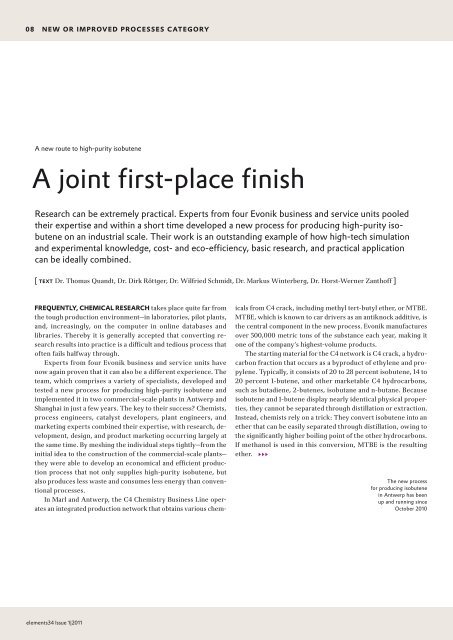Download - Evonik Industries
Download - Evonik Industries
Download - Evonik Industries
You also want an ePaper? Increase the reach of your titles
YUMPU automatically turns print PDFs into web optimized ePapers that Google loves.
08 neW or improved proCesses Category<br />
A new route to high-purity isobutene<br />
A joint first-place finish<br />
Research can be extremely practical. Experts from four <strong>Evonik</strong> business and service units pooled<br />
their expertise and within a short time developed a new process for producing high-purity iso -<br />
bu tene on an industrial scale. Their work is an outstanding example of how high-tech simulation<br />
and experimental knowledge, cost- and eco-efficiency, basic research, and practical application<br />
can be ideally combined.<br />
[ text Dr. Thomas Quandt, Dr. Dirk Röttger, Dr. Wilfried Schmidt, Dr. Markus Winterberg, Dr. HorstWerner Zanthoff ]<br />
Frequently, CHemiCal researCH takes place quite far from<br />
the tough production environment—in laboratories, pilot plants,<br />
and, increasingly, on the computer in online databases and<br />
li braries. Thereby it is generally accepted that converting research<br />
results into practice is a difficult and tedious process that<br />
often fails halfway through.<br />
Experts from four <strong>Evonik</strong> business and service units have<br />
now again proven that it can also be a different experience. The<br />
team, which comprises a variety of specialists, developed and<br />
tested a new process for producing highpurity isobutene and<br />
implemented it in two commercialscale plants in Antwerp and<br />
Shanghai in just a few years. The key to their success? Chemists,<br />
process engineers, catalyst developers, plant engineers, and<br />
mark eting experts combined their expertise, with research, development,<br />
design, and product marketing occurring largely at<br />
the same time. By meshing the individual steps tightly—from the<br />
initial idea to the construction of the commercialscale plants—<br />
they were able to develop an economical and efficient production<br />
process that not only supplies highpurity isobutene, but<br />
also produces less waste and consumes less energy than conventional<br />
processes.<br />
In Marl and Antwerp, the C4 Chemistry Business Line operates<br />
an integrated production network that obtains various chem<br />
elements34 Issue 1|2011<br />
icals from C4 crack, including methyl tertbutyl ether, or MTBE.<br />
MTBE, which is known to car drivers as an antiknock additive, is<br />
the central component in the new process. <strong>Evonik</strong> manufac tures<br />
over 500,000 metric tons of the substance each year, mak ing it<br />
one of the company‘s highestvolume products.<br />
The starting material for the C4 network is C4 crack, a hydrocarbon<br />
fraction that occurs as a byproduct of ethylene and propylene.<br />
Typically, it consists of 20 to 28 percent isobutene, 14 to<br />
20 percent 1butene, and other marketable C4 hydrocarbons,<br />
such as butadiene, 2butenes, isobutane and nbutane. Because<br />
isobutene and 1butene display nearly identical physical properties,<br />
they cannot be separated through distillation or extraction.<br />
Instead, chemists rely on a trick: They convert isobutene into an<br />
ether that can be easily separated through distillation, owing to<br />
the significantly higher boiling point of the other hydrocarbons.<br />
If methanol is used in this conversion, MTBE is the resulting<br />
ether. 333<br />
The new process<br />
for producing isobutene<br />
in Antwerp has been<br />
up and running since<br />
October 2010

















